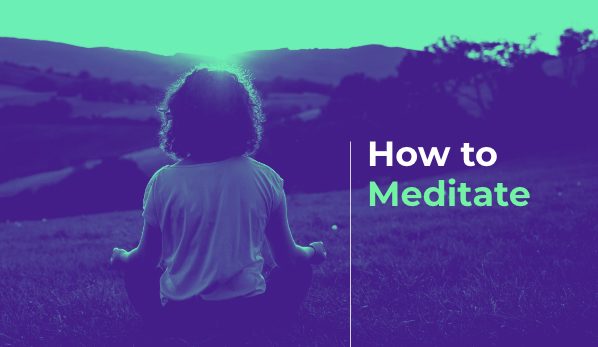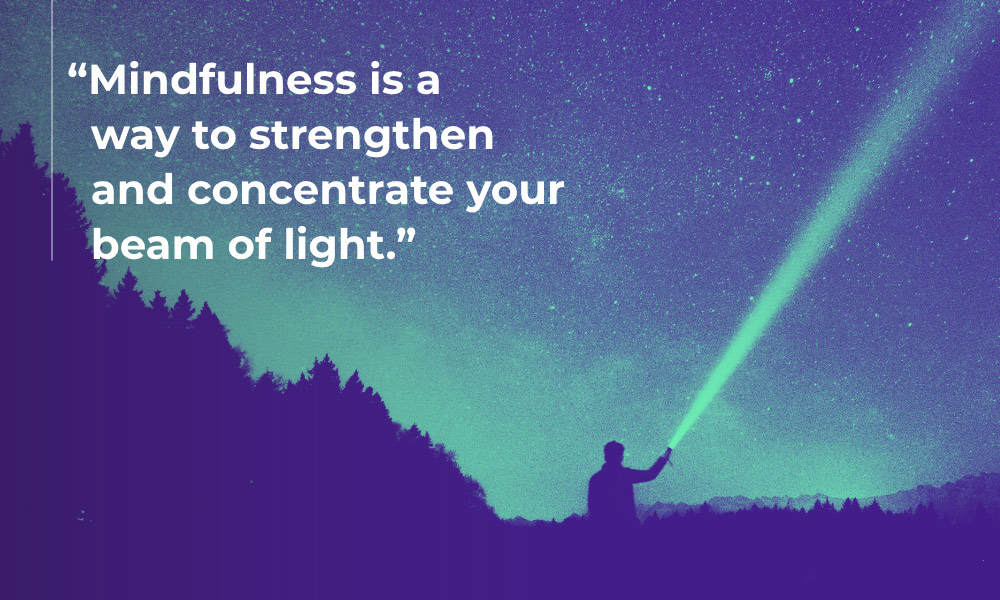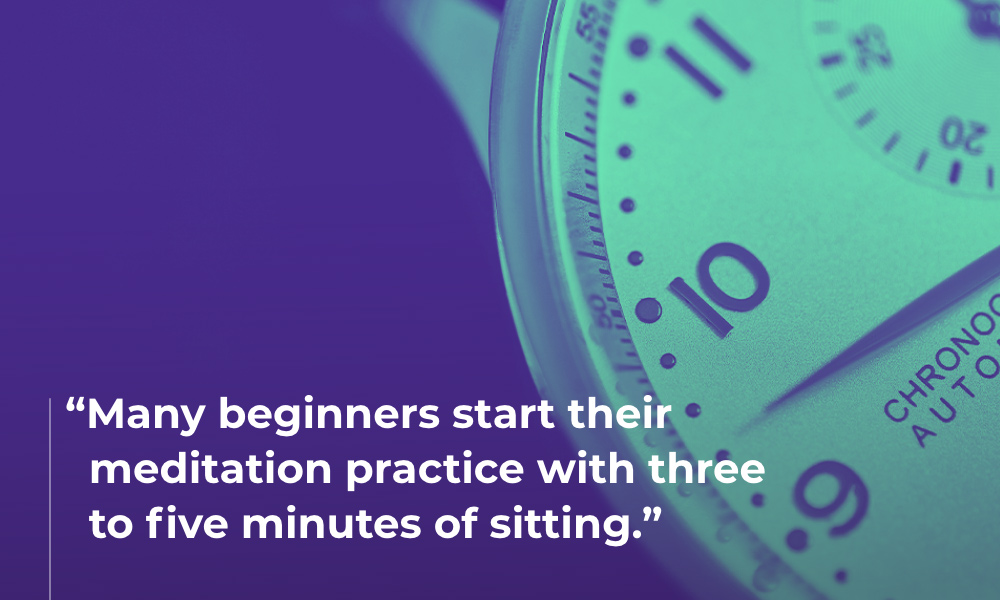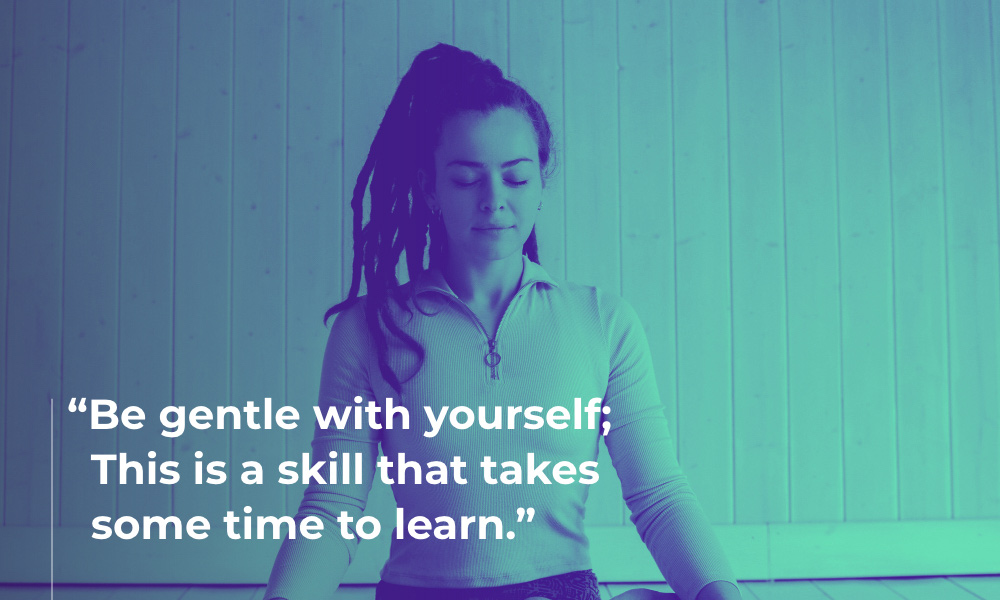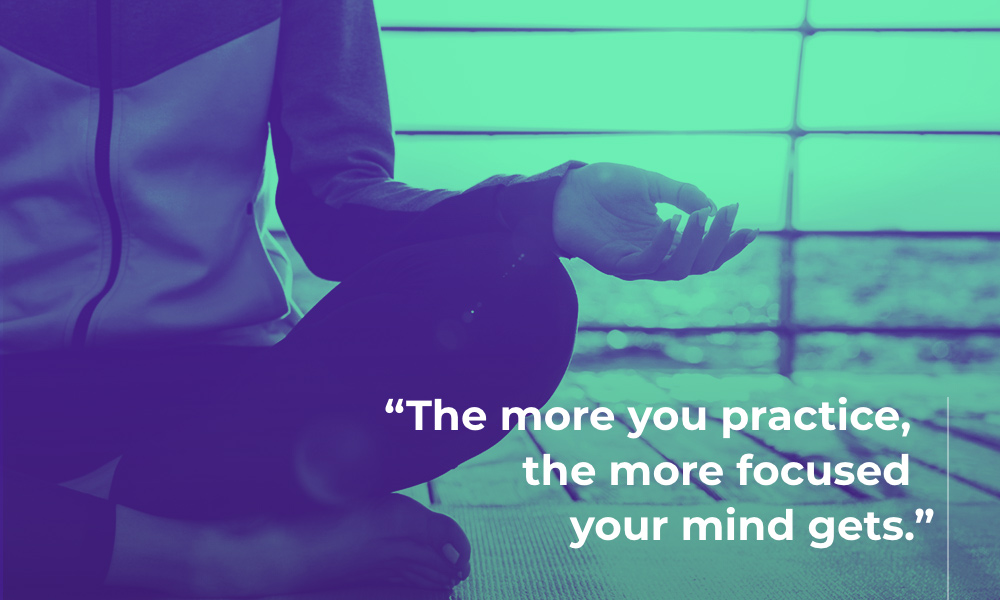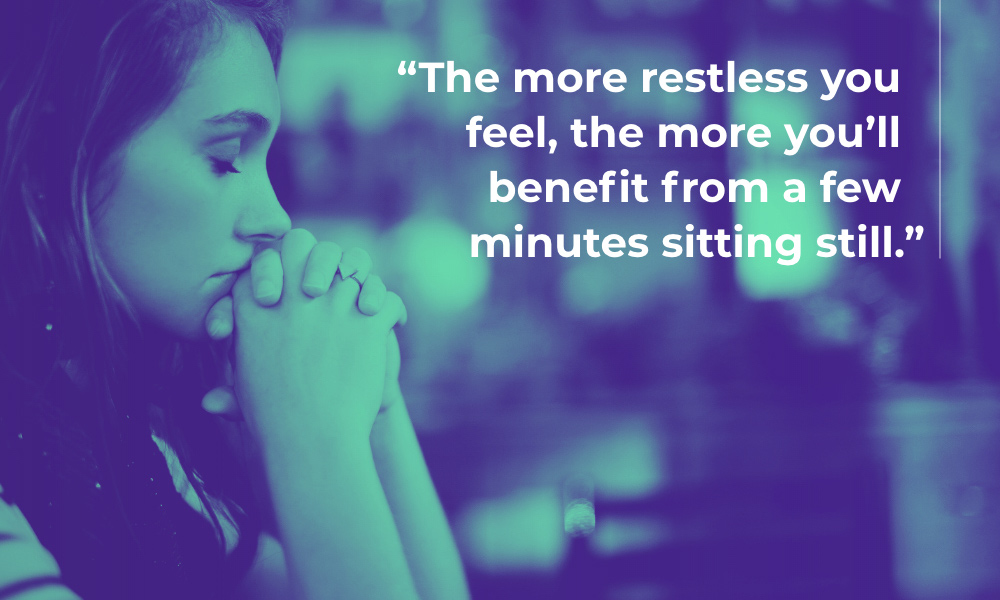What comes to your mind when you think about meditation? Do you imagine a yogi perched on a pillow? What about Joe Rogan, Ariana Huffington, or Oprah Winfrey—do you think of them?
If the last few surprised you, it’s time to take another look at meditation. Known for its anxiety-reducing and calm-enhancing benefits, meditation has garnered a specific yogic reputation. But wildly successful entrepreneurs like Rogan, Huffington, and Winfrey know that meditation can do a lot more than just help you chill out. These moguls meditate daily because they know it’s one of the best ways to develop increased productivity, creativity, and mental acuity in the workplace.
Whether you’d like to learn how to meditate to become sharper at work, get centered at home, or both, we’re happy you’re here. Let’s learn how to meditate.
What Is a Meditation Practice?
To learn what meditation is, we must first look at what meditation is not.
First, it’s good to know that meditation is not inherently religious or spiritual. You don’t have to be a Buddhist or subscribe to any specific belief system to practice meditation. Many people do indeed use meditation to feel connected to a higher power, but just as many people don’t. Either way is perfectly fine.
There’s another common misconception that meditation is a way to “empty your brain” or to stop your thoughts from happening completely. That’s not the case. Instead, imagine your brain as a flashlight. Meditation doesn’t shut the light off; it just focuses the light on one specific area.
What should you focus on? Well, it’s up to you. Most beginning meditators—and many advanced ones too—practice mindfulness meditation. Mindfulness meditation is when you focus on your breath or the sensations in your body. (We’ll get more into this and a few other meditation techniques in a bit.)
At the end of the day, meditation is a way to train your brain. Just like with any other muscle, you can train your brain into prime condition through consistent practice. And the goal of meditation practice is to cultivate awareness and mindfulness in all aspects of your life.
What is Mindfulness?
Mindfulness can seem like a buzzword, especially regarding meditation. In fact, sometimes, meditation and mindfulness are even treated as the same thing.
In reality, mindfulness is not the same as meditation, but it is a part of it. Mindfulness is when you direct all of your attention to something, like your body or your breath. To use our flashlight example, mindfulness is a way to strengthen your beam of light.
How to Prepare for Meditation
The best thing about meditation is that you can do it just about anytime and anywhere—even right before a big meeting—and it doesn’t require any special tools or equipment.
Here are some simple tips for getting the most out of your meditation experience:
Consider Timing
Though you can do it any time, you may want to pick a specific time of day for your meditation practice. This helps you develop a strong habit. We recommend meditating at one of the following times:
- First thing in the morning
- Right before you go to sleep
- When you’ve finished work for the day
- On your lunch break
The suggestions above can help you build a habit of meditation, but you can also meditate whenever you need a dose of calm and clarity (for example, before you meet with an investor).
Choose a Location
Just like you might find it helpful to have a consistent meditation time, you might also benefit from a consistent meditation location. Choose a quiet spot where you won’t be disturbed and try to use that same location every day. If you like to meditate on the floor with a cushion, for example, you might place a meditation cushion in an unused corner of your bedroom or office.
Select a Duration
Meditation has no time limits; you can do it for as long or as short as you like. (Although, we do suggest at least one minute since it takes that long to settle in.) We recommend choosing the duration of your session before you begin.
Otherwise, you may get restless and stop sooner than you planned. Of course, if you reach the end of your set time and want to keep going, you’re more than welcome to do so!
Many beginners start their meditation practice with three to five minutes of sitting. We suggest using a timer or a meditation app to track the time for you, so you don’t have to think about it while meditating.
Choose Your Clothing
One good thing about exercising your brain? No athletic wear required. There are zero clothing or uniform requirements to meditate. But if possible, it’s best to wear something soft and comfortable. After all, when tight jeans are digging into your hips, it’s hard to focus on anything else.
Select Your Gear
You can meditate perfectly without any equipment, and a lot of people do. But if you prefer to meditate on the floor (rather than in a straight-backed chair), you may be more comfortable sitting on a cushion. You can buy a meditation cushion online, but feel free to use a pillow from your couch or bed to start.
How to Start Meditating (Step-by-Step Mindfulness Meditation Guide)
This is the fun part! Now that you’re ready to meditate, it’s time to select what type of meditation you want to do. There are dozens of different types of meditation, but we recommend starting with a mindfulness meditation to help you cultivate awareness. Here’s how to do it:
Step 1: Sit Comfortably
Sit in an upright position to avoid falling asleep. It’s usually best to choose a straight-backed chair (like the kind you have at your dining room table) or to sit on a cushion on the floor. If you find it comfortable, you can also sit in lotus position, with your legs crossed and your feet resting on your thighs.
Keep your spine straight, but do your best to relax the rest of your body. Do a quick scan from head to toe to see if any body parts are holding onto tension, and if so, gently release them. If you prefer, you can close your eyes, or leave them open, focusing your gaze on one thing.
Step 2: Tune in to Your Breath
Begin your meditation by taking a few deep breaths, breathing into your belly. Focus all of your attention on your in-breath. Then focus all of your attention on your out-breath. If it helps you stay on track, count your breaths. Or you can focus on the area of your body where you feel your breath most strongly (for example, your nostrils, your chest, or your belly).
After you’ve taken several deep breaths, return your breathing to normal. But continue to focus all of your attention on your inhales and exhales.
Step 3: Notice Your Thoughts as They Arise
Your mind may drift from your breath frequently. This is normal! Even the most advanced meditators experience this.
When you notice your mind wandering, simply note that it happened, and then return to your breath. It may be helpful to mentally label this wandering as “thinking.”
One purpose of meditation is to learn to direct your mind, so by repeating this process again and again, you’re working toward an important goal.
Step 4: Do a Body Scan
If you’re enjoying following your breath, you’re welcome to continue doing so. But if you’d like to try something different, you can switch to a body scan.
To do a body scan, begin by bringing your awareness to the top of your head. Then move to your forehead, your nose, your jaw, and so on, all the way down to your toes. As you go, make a note of whatever you feel in each area of your body, whether it’s pain, numbness, tingling, or something else entirely.
A big component of meditation is non-judgment, so we’re not looking to assign a value to anything you notice. If you detect pain in a certain area of your body, try to observe the pain with curiosity, rather than succumbing to it. Notice where the pain lives, what it feels like, and explore within it. Be gentle with yourself; this is a skill that takes some time to learn.
Step 5: Return Awareness to Your Surroundings
Once you’ve completed your mindfulness meditation, take a moment to softly return your awareness to your surroundings. Flex your toes and fingers and take a couple of deep breaths before opening your eyes and continuing with your day.
Congratulations! You’ve just completed your first meditation session.
Different Types of Meditation
There are many different types of meditation—enough to keep you engaged for life. But when you’re just starting out, there are a few common types that you’ll definitely want to try.
Mindfulness Meditation
Mindfulness meditation is what we just walked through above, and it’s one of the most common types of meditation. You typically practice it by directing all of your attention to your body or your breath. It’s used by beginner and experienced mediators alike. Think of it as “home base,” meaning it can be your go-to meditation for day-to-day life, and you can return to it whenever you need a dose of calm and clarity.
Body Scan Meditation
A body scan meditation (which we also walked through above) is a type of mindfulness meditation. With body scan meditation, you bring awareness to each part of your body in succession, releasing tension and noticing sensations as you go. This one is especially great for releasing stress before a big presentation or for recuperating after a frustrating meeting.
Walking Meditation
Try a walking meditation on your next lunch break! Begin by walking slowly, and as you walk, cultivate awareness of your body as it moves. Feel your feet as they hit the ground, notice the sway of your arms, and pay attention to your breath as you pick up your pace. We suggest this one as a complement to your seated meditation practice.
Loving-Kindness Meditation
This is a special meditation that makes an excellent supplement to your mindfulness meditation practice. To practice a loving-kindness meditation, send thoughts of compassion and kindness to yourself and to others, like family, friends, and even difficult clients. You can even visualize giving love to your younger self. Studies show that this type of meditation increases your sense of social connection and decreases your bias toward others, so this is the perfect one to do before meeting with your team.
Benefits of Meditation
There are dozens upon dozens of health benefits to meditation. Some benefits are anecdotal while others are backed by authoritative studies. Here are just a few of them:
Manage Stress Better
There’s no way around it: Being a high performer comes with a heaping dose of stress. But as Hans Selye, a pioneering endocrinologist, said, “It’s not stress that kills us; it is our reaction to it.”
Enter: meditation. Science demonstrates that sitting with your breath can help you manage stress by reducing the inflammation response it causes. So while you may not be able to control stress, meditation can help you manage your reaction to it.
Increase Self-Awareness
Once you know better, you can do better. This is true in both your personal and professional life. That’s why it’s so important to be aware of your own thought patterns, motivations, and more. Meditation is proven to help you develop your self-awareness, so you can stop living your life auto-pilot.
Live in the Present Moment
As a high performer, you’re likely always looking a quarter (or four!) ahead. But the reality is that you’re building a business right here and now. And that’s where your attention should be too. With so many things pulling your focus, it’s critical to keep your attention on the task at hand, and meditation teaches you how to do that.
A meditation practice involves returning your mind to your breath repeatedly. This strengthens a mental muscle that you can use in the office when your mind wanders to what needs to be done tomorrow, next month, or next year.
Experience Less Negative Thinking
Negative thinking can cause biased information processing, pessimism, and cognitive distortions, all of which can distract you from doing your best work. Luckily, studies suggest that mindfulness meditation can improve your mental health by helping you experience fewer of these negative thoughts.
Feel Less Anxious
Anxiety can make the difference between killing it in a presentation or bombing hard. But happily, studies show that meditation can reduce anxiety. The more anxiety you have, the more effective meditation is at relieving it.
Feel Less Depressed
Millions of Americans suffer from depression, but the good news is that meditation can help. In one study of thousands of depressed adults, regular mindfulness meditation was shown to have a notable impact on symptoms of their depression.
Focus Better
In our modern world, we’re constantly experiencing information overload, and that’s doubly true in business. The most valuable thing you can cultivate in this environment? Focus, of course. Meditation helps here, too.
Meditation improves your focus just like lifting weights improves your strength. Sure it’s hard at first, but the more weights you lift, the stronger you become. Likewise in meditation, it may be difficult to focus at the beginning, but the more you practice, the more focused your mind gets.
Be More Creative
Any successful entrepreneur will tell you that creativity is one of the most underrated skills you need to succeed. You have to think outside of the box in order to make it big, so it’s wise to cultivate your innovation skills. Meditation is great for this too, with studies showing increased creative problem-solving capabilities in regular meditators.
Make Better Decisions
What do you get when you combine someone who’s self-aware, present, creative, and focused? An excellent decision-maker. Although the research is new here, some studies strongly suggest that regular meditation helps you make better decisions, both inside and outside of the workplace.
Challenges Within Meditation
Like most things that are worth doing, meditation can be difficult. But when you face challenges on your meditation journey, you can rest assured that they’re normal and expected. Attitude and expectations play a big role here, so try to remember that not only is it typical to struggle, but it’s a critical part of the process of training your mind. Here are some obstacles you may face at different points on your meditation journey:
Restlessness
Today, we have constant entertainment at our fingertips. So it can be hard to put away distractions and meditate. If you’re not used to sitting with your thoughts, you may feel restless. There are plenty of other reasons your body may not want to settle down, too—from too much caffeine to a looming client deadline.
Surprisingly, when you feel you have too many things to do, this is the perfect time to meditate. Sukhraj S. Dhillon, author of “The Power of Breathing,” says, “You should sit in meditation for twenty minutes everyday — unless you’re too busy; then you should sit for an hour.” While we won’t make you meditate for an hour, we agree with the point he makes. The more restless you feel, the more you’ll benefit from a few minutes of sitting still.
Fearful Thoughts
When you meditate, all types of thoughts move through your mind. But because you’re often most uncomfortable with the fearful thoughts, they tend to stick out. As you sit with these thoughts, you can observe them without judgement.
Eventually, you’ll come to realize that your fearful thoughts are no different than your happy, silly, or excited thoughts, and they’re no more permanent, either.
If you find yourself deep in a fearful thought, gently direct your attention to what the fear feels like. Identify where it’s located. Do you feel a tightness in your chest or throat? What about tension in your jaw? As you explore these feelings, they may even begin to dissipate.
Sleepiness
Meditation can be relaxing, but when it’s too relaxing, there are a few things you can do to avoid nodding off. First, ensure that you’re sitting upright. Especially if you’re prone to sleepiness, we don’t recommend meditating lying down and/or in bed.
If you’re meditating first thing in the morning, give your body some time to wake up before you begin your practice. You may want to have a cool glass of water or do some light stretching before you begin. Similarly, try not to meditate after a big meal. If you’re practicing on your lunch break, add a quick walk between your lunch and your meditation session.
Physical Pain
Meditation shouldn’t cause pain in any part of the body, and if it does, we recommend sitting in a more comfortable position. But because meditation encourages you to tune in to the sensations of your body, you may become more aware of any pre-existing, temporary, or chronic pain during your practice.
The trick here is to acknowledge and observe the pain without judgement. It may seem counterintuitive, but the more you explore the sensation of the pain, the less intense the pain will feel.
Distractions
An essential part of meditation is learning to tune in to your breath, even when there are distractions around you. That said, you’re still encouraged to choose a time and place where distractions will be at a minimum.
Don’t forget to turn off or silence your phone. And if you’re meditating at work, block that time off on your calendar so colleagues know not to disturb you.
If an irritating sound does arise while you’re meditating (say, a colleague speaking on the phone or construction happening next door), turn it into a mindfulness tool. You can do so by tuning in to the sound and following it the way you would your breath.
Self-Judgement
It’s easy to become frustrated with yourself when your mind wanders, but take comfort in knowing that everyone who’s ever meditated has experienced the same thing. Plus, the entire point of meditation is to notice when your mind wanders and bring it back.
It’s a proven fact that you’ll make more progress when you show yourself compassion rather than criticism. This is true in all of your pursuits. So simply notice when your mind drifts and gently bring it back to your breath—no judgement required.
Frequently Asked Questions About Meditation
Meditation is new to many people, and it’s natural to have questions about it. Let’s go over some meditation FAQs.
What Do I Focus on While Meditating?
You can start by focusing on the rhythmic pattern of your breath. First the inhalation, then the exhalation. Then, if you’d like, shift to observing the physical sensations in your body, moving your awareness gradually from head to toe.
If neither of those options appeal to you, you can do a loving-kindness meditation (where you mentally send kind thoughts to yourself and to others) or a gratitude meditation (where you focus on what you’re grateful for).
Or, you can simply tune in to your underlying mood and feelings. But if you choose this option, be sure to focus on what your mood feels like, rather than what caused the mood. For example, explore the sensation of anger, rather than ruminating on the colleague who made you angry.
How Do I Know Meditation is Working?
Like any healthy change you make in your life, you’ll likely see results from meditation gradually over time. You may enjoy a decrease in anxiety or depression, and you may feel less upset by life’s problems. You’ll likely feel more self-aware, and you’ll experience a greater sense of inner peace and well-being.
How Long Should I Meditate for the First Time?
We suggest that beginning meditators sit for three to five minute sessions. You can gradually increase your meditation sessions to 10, 15, 30 or even 60 minutes. But, start slow. Remember, there’s no rush.
Can I Meditate in Bed?
Because meditation can make you sleepy, it’s usually not recommended to meditate while lying down. However, meditating in bed is better than not meditating at all!
What Type of Meditation Should I do?
Choose the meditation type that most appeals to you. However, most beginners start with mindfulness meditation.
Guided Meditation With Meditation Apps
Meditation has many benefits, but it can be difficult to get started. Some beginners find it intimidating or even isolating.
For that reason, we recommend starting with a guided meditation app, which will gently walk you through your daily meditation practice. Apps are like meditation teachers in the palm of your hand. They help you stay on track, reminding you to return to your breath and keeping you motivated to practice each day. Primed Mind is a meditation app designed to condition your mind for achieving goals in both your professional and personal life.
Final Thoughts
We hope you’ve learned that meditation is not only a practice that’s accessible to you, but it’s one that can greatly improve your wellness in work and in life. With regular practice, you’ll feel calmer, more focused, more motivated, and even more energetic and creative.
Maybe it’s your first time meditating, maybe you used to meditate but you fell off your practice, or maybe you’ve been meditating for years—regardless of where you are in your meditation journey, we can help. Primed Mind is here to help you develop the clarity and motivation you need to improve your mindset, enhance your business, and optimize your life.

